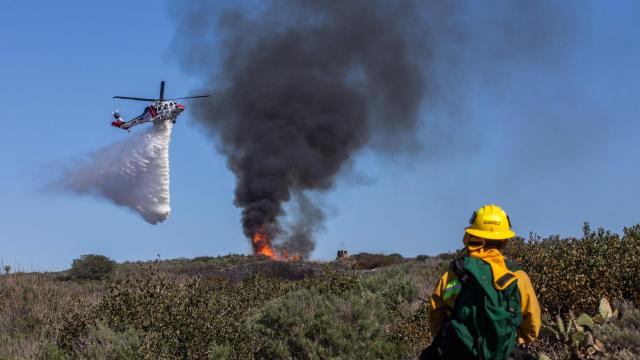This year’s Super Bowl in Los Angeles could see record-setting temperatures in the middle of winter. The heat wave is helping fires to spark in the region, even in the usually fire-free winter months.
“We no longer have a fire season — we have a fire year,” Orange County Fire Authority Chief Brian Fennessy told reporters at a briefing. “It’s February 10. It’s supposed to be the middle of winter. We’re anticipating 80-, 90-degree weather.”
The National Weather Service on Friday warned that a heat advisory was in effect for several cities and regions in Southern California through Sunday evening. While the highs might not sound that extreme for California — temperatures could reach up to 90 degrees Fahrenheit (32.2 degrees Celsius) — it’s pretty hot for LA at this time of year, which normally sees daily highs in the high 60s Fahrenheit (18 to 20 degrees Celsius).
LA’s record high for February was set in 1995, at 95 degrees Fahrenheit (35 degrees Celsius); the warm weather this weekend could break some records in the region. The hottest Super Bowl kickoff was also in Los Angeles, where the 1973 game was played in 84-degree Fahrenheit (28.8-degree Celsius) weather; this year’s Super Bowl looks set to hit or break that record.
Before this week, the NWS had only issued heat advisories between April and October; these warnings are the first heat advisories the NWS has ever issued for California in February. NWS cautioned that the heat could cause illness and advised people to take “extra precautions if you work or spend time outside.”
People living in and visiting Los Angeles might be spending a lot of time outside for this weekend’s game. The Super Bowl will be played at the SoFi stadium in Inglewood, which is forecast to reach 85 degrees Fahrenheit (29.4 degrees Celsius) on Sunday.
The unusually hot weather is also giving a boost to dangerous wildfires. Firefighters battled the Emerald Fire in Laguna Beach as residents were briefly under an evacuation order; as of Friday, that fire was 20% contained and had burned 145 acres. Another small brush fire broke out Thursday in Whittier, a suburb of Los Angeles, and destroyed two homes; firefighters were able to contain a small half-acre fire, dubbed the Imperial Fire, also on Thursday.
These fires, while relatively tiny compared to the apocalyptic monsters that gobbled up hundreds of thousands of acres this summer, are worrying because they’re happening in winter. December was fairly rainy and snowy for much of California, bringing some much-needed precipitation to the parched state. But the dry weather is back, along with some unexpected fire activity: in late January, a fire swept through in Big Sur, exhibiting some “surreal” behaviour by burning through an area that had just seen a lot of precipitation and doesn’t usually see wildfires.
“Anecdotally it seems as though the long-term drought is acting like a chronic illness,” the National Weather Service said. Rains and cold weather, the NWS continued, “isn’t helping to keep fires from developing.”
